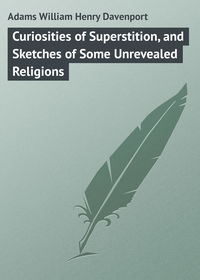 полная версия
полная версияWitch, Warlock, and Magician
In support of this extraordinary story, the elder Robinson deposed that he had certainly sent his son to bring in the kine; that, thinking he was away too long, he had gone in search of him, and discovered him in such a distracted condition that he knew neither his father nor where he was, and so continued for very nearly a quarter of an hour before he came to himself.
The persons implicated by the boy Robinson were immediately arrested, and confined in Lancaster Castle. Some of them – for he told various stories, and in each introduced new characters – he did not know by name, but he protested that on seeing them he should recognise them, and for this purpose he was carried about to the churches in the surrounding district to examine the congregations. The method adopted is thus described by Webster: ‘It came to pass that this said boy was brought into the church of Kildwick, a large parish church, where I (being then curate there) was preaching in the afternoon, and was set upon a stall (he being but about ten or eleven years old) to look about him, which moved some little disturbance in the congregation for awhile. And, after prayers, I inquiring what the matter was, the people told me it was the boy that discovered witches, upon which I went to the house where he was to stay all night, where I found him and two very unlikely persons that did conduct him and manage his business. I desired to have some discourse with the boy in private, but they utterly refused. Then, in the presence of a great many people, I took the boy near me and said: “Good boy, tell me truly, and in earnest, didst thou see and hear such strange things of the meeting of witches as is reported by many that thou dost relate, or did not some person teach thee to say such things of thyself?” But the two men, not giving the boy leave to answer, did pluck him from me, and said he had been examined by two able justices of the peace, and they did never ask him such a question; to whom I replied, the persons accused therefore had the more wrong.’
In all, some eighteen women, married and single – the charge was generally made against women, as probably less capable of self-defence, and more impressionable than men – were brought to trial at Lancaster Assizes. There was really no evidence against them but the boy Robinson’s, and to sustain it his unfortunate victims were examined for the stigmata, or devil-marks, which, of course, were found in ample quantity. Against seventeen a verdict of guilty was returned, one or two being convicted on their own confessions – the most perplexing incident in the whole case, for as these confessions were unquestionably false, they who made them were really lying away their own lives. By what impulse of morbid vanity, or diseased craving for notoriety, or strange mental delusion, were they inspired? And whence came the wild and even foul ideas which formed the staple of their delirious narratives? How did these quiet, stolid, unlettered Lancashire peasant-women become possessed of inventions worthy of the grimmest of German tales of diablerie? It is easier to ask these questions than to answer them; but when the witch mania was once kindled in a neighbourhood it seems, like a pestilential atmosphere, to have stricken with disease every mind that was predisposed to the reception of unwholesome impressions.
The confession of Margaret Johnson, made on March 9, 1613, has been printed before, but it has so strong a psychological interest that I cannot omit it here. It may be taken as a type of the confessions made by the victims of credulity under similar circumstances:
‘Betweene seven or eight yeares since, shee being in her house at Marsden in greate passion and anger, and discontented, and withall oppressed with some want, there appeared unto her a spirit or devill in the similitude and proportion of a man, apparelled in a suite of black, tied about with silke pointes, whoe offered her, yff shee would give him her soule, hee would supply all her wantes, and bring to her whatsoever shee wanted or needed, and at her appointment would helpe her to kill and revenge her either of men or beastes, or what she desired; and, after a sollicitation or two, shee contracted and condicioned with the said devill or spiritt for her soule. And the said devill bad her call him by the name of Memillion, and when shee called hee would bee ready to doe her will. And she saith that in all her talke and conference shee called the said Memillion her god.
‘And shee further saith that shee was not at the greate meetinge of the witches at Hare-stones in the forest of Pendle on All Saintes Day last past, but saith shee was at a second meetinge the Sunday after All Saintes Day at the place aforesaid, where there was at that time betweene thirty and forty witches, which did all ride to the same meetinge. And thead of the said meetinge was to consult for the killing and hunting of men and beastes; and that there was one devill or spiritt that was more greate and grand devill than the rest, and yff anie witch desired to have such an one, they might have such an one to kill or hurt anie body. And she further saith, that such witches as have sharpe boanes are generally for the devill to prick them with which have no papps nor duggs, but raiseth blood from the place pricked with the boane, which witches are more greate and grand witches than they which have papps or dugs (!). And shee being further asked what persons were at their last meetinge, she named one Carpnell and his wife, Rason and his wife, Pickhamer and his wife, Duffy and his wife, and one Jane Carbonell, whereof Pickhamer’s wife is the most greate, grand, and anorcyent witch; and that one witch alone can kill a beast, and yf they bid their spiritt or devill to goe and pricke or hurt anie man in anie particular place, hee presently will doe it. And that their spiritts have usually knowledge of their bodies. And shee further saith the men witches have women spiritts, and women witches have men spiritts; that Good Friday is one of their constant daies of their generall meetinge, and that on Good Friday last they had a meetinge neere Pendle water-side; and saith that their spirit doeth tell them where their meetinge must bee, and in what place; and saith that if a witch desire to be in anie place upon a soddaine, that, on a dogg, or a tod, or a catt, their spiritt will presently convey them thither, or into anie room in anie man’s house.
‘But shee saith it is not the substance of their bodies that doeth goe into anie such roomes, but their spiritts that assume such shape and forme. And shee further saith that the devill, after hee begins to sucke, will make a papp or a dug in a short time, and the matter hee sucketh is blood. And further saith that the devill can raise foule wether and stormes, and soe hee did at their meetinges. And shee further saith that when the devill came to suck her pappe, he came to her in the likeness of a catt, sometimes of one collour, and sometimes of another. And since this trouble befell her, her spirit hath left her, and shee never saw him since.’
Happily, the judge who presided at the trial of these deluded and persecuted unfortunates was dissatisfied with the evidence, and reprieved them until he had time to communicate with the Privy Council, by whose orders Bridgman, Bishop of Chester, proceeded to examine into the principal cases. Three of the supposed criminals, however, had died of anxiety and suffering before the work of investigation began, and a fourth was sick beyond recovery. The cases into which the Bishop inquired were those of Margaret Johnson, Frances Dicconson, or Dickinson, Mary Spencer, and Mrs. Hargrave. Margaret Johnson the good Bishop describes as a widow of sixty, who was deeply penitent. ‘I will not add,’ she said, ‘sin to sin. I have already done enough, yea, too much, and will not increase it. I pray God I may repent.’ This victim of hallucination had confessed herself to be a witch, as we have seen, and was characterized by the Bishop as ‘more often faulting in the particulars of her actions.’ Frances Dicconson, however, and Mary Spencer, absolutely denied the truth of the accusations brought against them. Frances, according to the boy Robinson, had changed herself into a dog; but it transpired that she had had a quarrel with the elder Robinson. Mary Spencer, a young woman of twenty, said that Robinson cherished much ill-feeling against her parents, who had been convicted of witchcraft at the last assizes, and had since died. She repeated the Lord’s Prayer and the Apostles’ Creed, and declared that she defied the devil and all his works. A story had been set afloat that she used to call her pail to follow her as she ran. The truth was that she often trundled it down-hill, and called to it in jest to come after her if she outstripped it. She could have explained every circumstance in court, ‘but the wind was so loud and the throng so great, that she could not hear the evidence against her.’
This last touch, as Mr. S. R. Gardiner remarks, completes the tragedy of the situation. ‘History,’ as he says, ‘occupies itself perforce mainly with the sorrows of the educated classes, whose own peers have left the records of their wrongs. Into the sufferings of the mass of the people, except when they have been lashed by long-continued injustice into frenzy, it is hard to gain a glimpse. For once the veil is lifted, and we see, as by a lightning flash, the forlorn and unfriended girl, to whom the inhuman laws of her country denied the services of an advocate, baffled by the noisy babble around her in her efforts to speak a word on behalf of her innocence. The very Bishop who examined her was under the influence of the legal superstition that every accused person was the enemy of the King. He had heard, he said, that the father of the boy Robinson had offered, for forty shillings, to withdraw his charge against Frances Dicconson, “but such evidence being, as the lawyers speak, against the King,” he “thought it not meet without further authority to examine.”’
The Bishop, however, like the judge, was dissatisfied with the evidence; and the accused persons were eventually sent up to London, where they were examined by the King’s physicians, the Bishops, the Privy Council, and by King Charles himself. Some medical men and midwives reported that Margaret Johnson was deceived in her idea that she bore on her body a sign or mark that her blood had been sucked. Doubts as to the truth of the boy Robinson’s story being freely entertained, he was separated from his father, and he then revealed the whole invention to the King’s coachman. He had heard stories told of witches and their doings, and out of these had concocted his ghastly fiction to save himself a whipping for having neglected to bring home his mother’s cows. His father, perceiving at once how much might be made out of the tale, took it up and expanded it; manipulated it so as to serve his feelings of revenge or avarice, and then taught the boy how to repeat the enlarged and improved version. It was all a lie – from beginning to end. The day on which he pretended to have been carried to the Witches’ Sabbath at the Hoar-Stones, he was a mile distant, gathering plums in a farmer’s orchard. The accused were then admitted to the King’s presence, and assured that their lives were safe. Further than this Charles seems to have been unable to go; for as late as 1636 these innocent and ill-treated persons were still lying in Lancaster Castle. It is satisfactory to state, however, that both the boy Robinson and his father were thrown into prison.
Fresh cases of witchcraft sprang up in the Pendle district, and early in 1636 four more women were condemned to death at the Lancaster Assizes. Bishop Bridgman, who was again directed to make inquiries, found that two of them had died in gaol, and that of the two others, one had been convicted on a madman’s evidence, and that of a woman of ill fame; while the only proof alleged against the other was that a fleshy excrescence of the size of a hazel-nut grew on her right ear, and the end of it, being bloody, was supposed to have been sucked by a familiar spirit. The two women seem to have been pardoned; but, as in the former case, public opinion set too strongly against them to admit of their being released.
THE WITCHES OF SALMESBURYThe singular circumstances connected with the supposed outbreak of witchcraft in Pendle Forest have, to a great extent, obscured the strange case of the witches of Salmesbury, though it presents several features worthy of consideration.
Three persons were accused – Jennet Bierley, Ellen Bierley, and Jane Southworth – and their supposed victim was one Grace Sowerbutts. In the language of Mr. Thomas Potts, they were led into error by ‘a subtle practice and conspiracy of a seminary priest, or Jesuit, whereof this county of Lancaster hath good store, who by reason of the general entertainment they find, and great maintenance they have, resort hither, being far from the eye of Justice, and, therefore, procul a fulmine.’ At their trial, which took place before Mr. Justice Bromley at Lancaster, on Wednesday, August 19, the evidence of Grace Sowerbutts was to the following effect:
That for the space of some years past (at the time of the trial she was only fourteen) she had been haunted and vexed by four women, namely, Jennet Bierley, her grandmother, Ellen Bierley, wife to Henry Bierley, Jane Southworth, and a certain Old Dorwife. Lately, these four women drew her by the hair of her head, and laid her on the top of a hay-mow in the said Henry Bierley’s barn. Not long after, Jennet Bierley met her near her house, first appearing in her own likeness, and after that as a black dog, and when she, Grace Sowerbutts, went over a stile, she picked her off. However, she was not hurt, and, springing to her feet, she continued her way to her aunt’s at Osbaldeston. That evening she told her father what had occurred. On Saturday, April 4, going towards Salmesbury Butt to meet her mother, she fell in, at a place called the Two Briggs, with Jennet Bierley, first in her own shape, and afterwards in the likeness of a two-legged black dog; and this dog kept close by her side until they came to a pool of water, when it spake, and endeavoured to persuade her to drown herself therein, saying it was a fair and an easy death. Whereupon, she thought there came to her one in a white sheet, and carried her away from the pool, and in a short space of time both the white thing and the black dog departed; but after Grace had crossed two or three fields, the black dog re-appeared, and conveyed her into Hugh Walshman’s barn close at hand, laid her upon the floor, covered her with straw on her body and hay on her head, and lay down on the top of the straw – for how long a time Grace was unable to determine; because, she said, her speech and senses were taken from her. When she recovered her consciousness, she was lying on a bed in Walshman’s house, having been removed thither by some friends who had found her in the barn within a few hours of her having been taken there. As it was Monday night when she came to her senses, she had been in her trance or swoon, according to her marvellous story, for about forty-eight hours.
On the following day, Tuesday, her parents fetched her home; but at the Two Briggs Jennet and Ellen Bierley appeared in their own shapes, and she fell down in another trance, remaining unable to speak or walk until the following Friday.
All this was remarkable enough, but Grace Sowerbutts – or the person who had tutored her – felt it was not sufficiently grim or gruesome to make much impression on a Lancashire jury, accustomed in witch trials to much more harrowing details. She proceeded, therefore, to recall an incident of a more attractive character. A good while, she said, before the trance business occurred, she accompanied her aunt, Ellen Bierley, and her grandmother, Jennet Bierley, to the house of one Thomas Walshman. It was night, and all the household were asleep, but the doors flew open, and the unexpected visitors entered. Grace and Ellen Bierley remained below, while Jennet made her way to the sleeping-room of Thomas Walshman and his wife, and thence brought a little child, which, as Grace supposed, must have been in bed with its father and mother. Having thrust a nail into its navel, she afterwards inserted a quill, and sucked for a good while(!); then replaced the child with its parents, who, of course, had never roused from their sleep. The child did not cry when it was thus abused, but thenceforth languished, and soon afterwards died. And on the night after its burial, the said Jennet and Ellen Bierley, taking Grace Sowerbutts with them, went to Salmesbury churchyard, took up the body, and carried it to Jennet’s house, where a portion of it was boiled in a pot, and a portion broiled on the coals. Of both portions Jennet and Ellen partook, and would have had Grace join them in the ghoul-like repast, but she refused. Afterwards Jennet and Ellen seethed the bones in a pot, and with the fat that came from them said they would anoint their bodies, so that they might sometimes change themselves into other shapes.
The next story told by this abandoned girl is too foul and coarse for these pages, and we pass on to the conclusion of her evidence. On a certain occasion, she said, Jane Southworth, a widow, met her at the door of her father’s house, carried her to the loft, and laid her upon the floor, where she was found by her father unconscious, and unconscious she remained till the next day. The widow Southworth then visited her again, took her out of bed, and placed her upon the top of a hayrick, three or four yards from the ground. She was discovered in this position by a neighbour’s wife, and laid in her bed again, but remained speechless and senseless as before for two or three days. A week or so after her recovery, Jane Southworth paid her a third visit, took her away from her home, and laid her in a ditch near the house, with her face downwards. The usual process followed: she was discovered and put to bed, but continued unconscious – this time, however, only for a day and a night. And, further, on the Tuesday before the trial, the said Jane Southworth came again to her father’s house, took her and carried her into the barn, and thrust her head amongst ‘a company of boards’ which were standing there, where she was soon afterwards found, and, being again placed in a bed, remained in her old fit until the Thursday night following.
After Grace Sowerbutts had finished her evidence, Thomas Walshman was called, who proved that his child died when about a year old, but of what disease he knew not; and that Grace Sowerbutts had been found in his father’s barn, and afterwards carried into his house, where she lay till the Monday night ‘as if she had been dead.’ Then one John Singleton’s deposition was taken: That he had often heard his old master, Sir John Southworth, say, touching the widow Southworth, that she was, as he thought, an evil woman and a witch, and that he was sorry for her husband, who was his kinsman, for he believed she would kill him. And that the said Sir John, in coming or going between Preston and his own house at Salmesbury, mostly avoided passing the old wife’s residence, though it was the nearest way, entirely out of fear of the said wife. (Brave Sir John!)
This evidence, it is clear, failed to prove against the prisoners a single direct act of witchcraft; but so credulous were judge and jury in matters of this kind, that, notwithstanding the vague and suspicious character of the testimony brought forward, it would have gone hard with the accused, but for an accidental question which disclosed the fact that the girl, Grace Sowerbutts, had been prompted in her incoherent narrative, and taught to sham her fits of unconsciousness, by a Roman priest or Jesuit, named Thompson or Southworth, who was actuated by motives of fanaticism.
‘How well this project,’ exclaims the indignant Potts, ‘to take away the lives of these innocent poor creatures by practice and villainy, to induce a young scholar to commit perjury, to accuse her own grandmother, aunt, etc., agrees either with the title of a Jesuit or the duty of a religious Priest, who should rather profess sincerity and innocency than practise treachery. But this was lawful, for they are heretics accursed, to leave the company of priests, to frequent churches, hear the word of God preached, and profess religion sincerely.’ The horrors which he taught his promising pupil, Thompson probably gathered from the pages of Bodin and Delrio, or some of the other demonologists. Potts continues:
‘Who did not condemn these women upon this evidence, and hold them guilty of this so foul and horrible murder? But Almighty God, who in His providence had provided means for their deliverance, although the priest, by the help of the Devil, had provided false witnesses to accuse them; yet God had prepared and placed in the seat of justice an upright judge to sit in judgment upon their lives, who after he had heard all the evidence at large against the prisoners for the King’s Majesty, demanded of them what answer they could make. They humbly upon their knees, with weeping tears, desired him for God’s cause to examine Grace Sowerbutts, who set her on, or by whose means this accusation came against them.’
The countenance of Grace Sowerbutts immediately underwent a great change, and the witnesses began to quarrel and accuse one another. The judge put some questions to the girl, who, for the life of her, could make no direct or intelligible answer, saying, with obvious hesitation, that she was put to a master to learn, but he had told her nothing of this.
‘But here,’ continues Potts, ‘as his lordship’s care and pains was great to discover the practices of those odious witches of the Forest of Pendle, and other places, now upon their tribunal before him; so was he desirous to discover this damnable practice to accuse these poor women and bring their lives in danger, and thereby to deliver the innocent.
‘And as he openly delivered it upon the bench, in the hearing of a great audience: That if a Priest or Jesuit had a hand in one end of it, there would appear to be knavery and practice in the other end of it. And that it might better appear to the whole world, examined Thomas Sowerbutts what [the] Master taught his daughter: in general terms, he denied all.
‘The wench had nothing to say, but her Master told her nothing of this. In the end, some that were present told his lordship the truth, and the prisoners informed him how she went to learn with one Thompson, a Seminary Priest, who had instructed and taught her this accusation against them, because they were once obstinate Papists, and now came to Church. Here is the discovery of this Priest, and of his whole practice. Still this fire increased more and more, and one witness accusing another, all things were laid open at large.
‘In the end his lordship took away the girl from her father, and committed her to Mr. Leigh, a very religious preacher, and Mr. Chisnal, two Justices of the Peace, to be carefully examined.’
The examination was as follows:
‘Being demanded whether the accusation she laid upon her grandmother, Jennet Bierley, Ellen Bierley, and Jane Southworth, of witchcraft, namely, of the killing of the child of Thomas Walshman with a nail in the navel, the boiling, eating, and oiling, thereby to transform themselves into divers shapes, was true; she doth utterly deny the same: or that ever she saw any such practices done by them.
‘She further saith, that one Master Thompson, which she taketh to be Master Christopher Southworth, to whom she was sent to learn her prayers, did persuade, counsel, and advise her, to deal as formerly hath been said against her said Grandmother, Aunt, and Southworth’s wife.
‘And further she confesseth and saith, that she never did know, or saw any Devils, nor any other Visions, as formerly by her hath been alleged and informed.
‘Also she confesseth and saith, that she was not thrown or cast upon the hen-ruff and hay-mow in the barn, but that she went up upon the Mow herself by the wall-side.
‘Being further demanded whether she ever was at the Church, she saith, she was not, but promised hereafter to go to the Church, and that very willingly.’
The three accused were also examined, and declared their belief that Grace Sowerbutts had been trained by the priest to accuse them of witchcraft, because they ‘would not be dissuaded from the Church.’
‘These examinations being taken, they were brought into the Court, and there openly in the presence of this great audience published and declared to the jury of life and death; and thereupon the gentlemen of their jury required to consider of them. For although they stood upon their Trial, for matter of fact of witchcraft, murther, and much more of the like nature: yet in respect all their accusations did appear to be practice, they were now to consider of them and to acquit them. Thus were these poor innocent creatures, by the great care and pains of this honourable Judge, delivered from the danger of this conspiracy; this bloody practice of the Priest laid open: of whose fact I may lawfully say, Etiam si ego tacuero clamabunt lapides.





